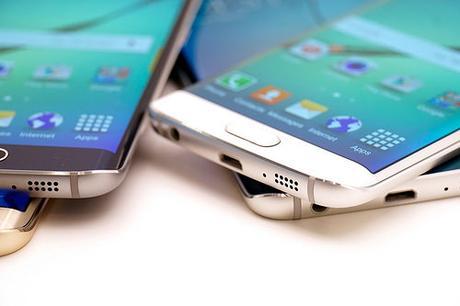
This post is sponsored by Samsung Business.
The debate regarding big screen vs. small screen goes far back in the history of display technology. However, now we have entered an era where there’s a huge demand for both. For instance, the digital signage market is booming—it’s currently the world’s second fastest growing ad medium. In fact, according to a 2014 report by Grand View Research, the global digital signage market is expected to reach $20.03 billion over the next six years.
There’s a similar growth in mobile device usage. Pew Research Center estimated that nearly two-thirds of Americans are now smartphone owners. But the actual physical number of smartphones in the U.S. is surely much, much higher, as many of us own more than one.
When you think of screen size, obviously digital signage and mobile devices are on opposite ends of the spectrum: One is a giant billboard, and the other fits in your pocket. Yet, even though they share the common goal of media consumption, and both help brands attract and engage their audiences there has been surprisingly little interactivity between the two. That said, if there’s one thing that is tying both technologies together it’s the swelling wave of big data. In fact, a time when mobile, data analytics, and big-screen displays come together in harmony isn’t that far away.
Big Screens Meets Small Screens to Become Smarter
When brands choose digital signage to communicate a message to their audience, it’s a one-way conversation, but that’s not the true essence of interaction. In the age where customers expect more engagement from brands, simply displaying information on a big screen doesn’t cut it anymore. Today’s empowered customers want to be in the driver’s seat. They don’t want to just consume content, they want to interact with it. Brands can shift the control to the customers by moving from only-display digital signage to more interactive and smarter signage.
Mobile integration into a digital signage platform is a significant step in this direction. In the retail landscape, technologies like QR codes, NFC, beacons, automated content recognition, and Snap Tags have emerged that allow brands to push their messages, offers, and discount coupons right into the hands of their customers, through their mobile devices. This presents better opportunities and more choices for connected consumers to engage with brands, in the way they prefer.
When Big Data Collides with Screens, Big and Small
Today, almost everything—from your car to your home appliances, to your smartphone, to your loyalty card to sensor-embedded devices and even ordinary physical objects—generates reams of data. Brands are using this data to create 1:1 and omni-channel customer experiences. They are drawing insights from data to get a more complete picture of their customers and ultimately make more accurate consumer predictions. Amazon and Walmart are excellent examples of how retailers are leveraging data.
Online retailers, for instance, are using navigation data, purchase history, and cookies to create offers and campaigns that have better click-through rates. Data analytics combined with digital signage can take retail promotions to a whole new level. Similarly, when it comes to mobile devices, brands can use big data to offer more personalized mobile experiences and more targeted mobile ads.
Location data, in particular, has the potential to transform the world of mobile ads, while it’s also the main driving force behind digital out-of-home (DOOH) advertising. The ability to deliver real-time, hyper-local, targeted advertising can be a significant improvement over more traditional media predecessors like static billboards or bus ads.
While the growing use case for mobile devices seems endless, the lure of big displays isn’t going to wear off anytime soon. The challenge lies in syncing the two worlds together so the user experience from large screen to tablet to mobile device is not only seamless, but highly relevant and personalized.
Digital Signage and the Internet of Everything
When smart displays meet smart things, the result is smart content. Want to learn more about the Internet of Things and Smart Digital Signage? Check out the slideshare from Samsung Business.
Digital Signage and the Internet of Everything from Samsung Business USAAdditional Resources on this Topic:
Five Things CIOs Should Know About Digital Signage
For Marketers Every Tech Trend Hinges On Big Data and Analytics
Why Beacons and Digital Signage Are BFFs
All thoughts and opinions are my own. For more content like this, follow Samsung Business on Insights, Twitter, LinkedIn , YouTube and SlideShare.
Photo Credit: TechStage via Compfight cc
This article was originally seen on Millennial CEO blog.

